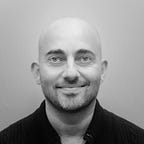Service designers shaping the future of the workplace
The workplace is becoming less fixed and more flexible — liberating employees to be productive when, where and how they work best. Hence there is more desire to work from anywhere and to balance work and life activities.
I will talk about a corporate project without trying not to give away too much. The challenge was to create a future work experience that allows employees to perform at their best in work and life through technology and flexible ways of working. We used human-centred design as a methodology to imagine a seamless experience where 10,000 employees cohabit a single corporate environment across a few adjacent newly constructed office buildings. Our approach involved creating behavioural archetypes, jobs to be done, co-designing, imagining and mapping future state journeys for all the teams cohabiting in the same space.
The target occupancy of 10,000 employees is as big as a town, and architects often are the first to consult for such a complex problem. The design challenge for architects was around how to balance the form and the function. How do you design indoor and outdoor spaces that people love and use? How do you decide who goes where and what utilities and services each floor need depending on the teams allocated? How do you do it on the budget — when different teams want to customise their own spaces and add something that may be non-standard.
At the time we were brought into the project, the conversations about the space have already progressed with the physical building, room and furniture decisions, rather than the human experience. Conversely, our emphasis was on the employees’ “jobs-to-be-done”, the activities and experiences that we want to create, which seemed like ten steps back, compared to where the project is. Our strategy was to decide what we want the space to do, then start thinking about how to enable that.
We started the future of workplace experience project, exploring the lives of employees, their emotional landscape, routines and challenges, pain points and unmet needs. During our qualitative research, we immersed ourselves across ten separate locations and spoke to a broad cross-section of teams. We have completed over 40 in-depth interviews and 20 subject matter expert interviews. We also shadowed 16 different teams while they worked, and observed thousands of interactions amongst our colleagues, collaborators, and people running our support facilities. The research helped us get a holistic view of the current state workplace experience from different lenses. To validate our findings, we completed a 10-minute survey with around 1000 employees. We developed meaningful insights combining quantitative with qualitative data, to increase our confidence.
After analysing 1000s of employee interactions and pain points, we created the six archetypes that present the different employee behaviours, distinct needs, attitudes, and motivations. Using this approach, we showed the overlaps and differences amongst such a diverse and broad workforce. We have also defined employees’ working modes, movement patterns (within and between buildings) and interaction/communication styles, which helped us inform how we design unique spaces and experiences.
Jobs-to-be-done (JTBD) framework helped us gain a deep understanding of employees’ tasks, activities and intents to perform their day to day jobs. Each “Job” definition focused on employees’ desired outcomes rather than their current pain points. The JTBD framework also helped us to focus on the functional, social and emotional layers that underpin getting their job done — which was a great introduction to ideation sessions. We facilitated co-design sessions with the employees to design the optimum work environment and culture so that they can be their best. Across the 18 ideation sessions, the employees created 100s of ideas, and more importantly, we observed similar ideas generated multiple times. We combined those based on similarity, and they evolved into our key concepts.
We focused on not only what the employee experience is today but imagined what the experience would look like tomorrow, facilitating future state/ ideal scenario mapping activities with them. With the experience concepts as guides, a series of workshops invited a core team of stakeholders, interior designers and employees to create new journeys, moment by moment. We allocated participants into six teams, each corresponding to a behavioural archetype. Each team designed the ideal flow for themselves by filling in a blank journey canvas, defining moments, descriptions, channels and experience attributes. The outcome was six different future journeys unique to each archetype based on their needs, and the jobs they want to do.
Furthermore, we created a signature journey; presenting a day in the life of an employee. It used storytelling to describe the future workplace experience through a narrated sketch note video (animated drawing). The production period of this animated video was entirely collaborative, bringing the design team and the stakeholders together to prioritise the moments, spaces and concepts that highlight what may go into a future viable service experience. In the future of the workplace, bots will plan the days and weeks, ease admin tasks, organise the meetings, and help people connect and socialise. Increasingly, more work will move to the digital realm and collaboration will be effective across remote locations, and different time zones
Human centred design as a methodology proved to be useful in workplace design, moving the focus from rooms, walls and furniture to the experiences we want to create. Through our large focus on empathy, we built the foundations for further prototyping and testing to take place in the following years. Workplace design is indeed new territory for experience and service designers, and a brilliant opportunity for us to start innovating the spaces we work and live in.
I would like to thank my super talented collaborators Victoria Gamble, Sam Adeloju, Irene Hanna
